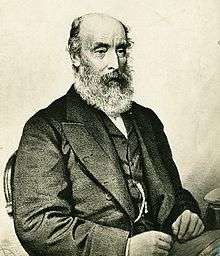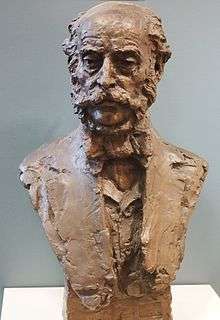Robert Torrens
| Sir Robert Torrens GCMG | |
|---|---|
 | |
| 3rd Premier of South Australia | |
|
In office 1 September 1857 – 30 September 1857 | |
| Monarch | Victoria |
| Governor | Sir Richard MacDonnell |
| Preceded by | John Baker |
| Succeeded by | Richard Hanson |
| Personal details | |
| Born |
1814 Cork, Co. Cork, Ireland, UK |
| Died |
31 August 1884 Falmouth, Cornwall, England, UK |
| Nationality | British |
| Alma mater | Trinity College, Dublin |
Sir Robert Richard Torrens, GCMG (1814 – 31 August 1884)[1] was the third Premier of South Australia and a pioneer and author of a simplified system of transferring land.
Biography

Early life
Torrens was born at Cork, Ireland, in 1814. His father, Colonel Robert Torrens, F.R.S., the distinguished economist, was one of the founders of South Australia. Sir Robert Torrens was educated at Trinity College, Dublin, where he graduated M.A. In 1839 he married Barbara, widow of Augustus George Anson, née Park, and the following year left for South Australia, arriving on the Brightman in December 1840.[2] In February 1841 he was collector of customs at Adelaide, and it is probable that he had received this position directly as he arrived. In the enlarged legislative council elected in July 1851, Torrens was one of the four official nominees nominated by the governor. When "responsible government" commenced in October 1856, Torrens became Treasurer of South Australia in the ministry of Finniss. He was elected as one of the members of the House of Assembly for the City of Adelaide[1] in the new parliament, and on 1 September 1857 became premier, but his government lasted only a month.[1]
Real Property Act 1858
In December 1857 he championed the Real Property Act of 1858 (for the transfer of real property) through the assembly, and the system became known as the Torrens title. The system transferred property by registration of title, instead of by deeds, and it has since been widely adopted throughout the world. Attempts have been made to minimise the credit due to Torrens for his great achievement, and it has been stated that Anthony Forster, then editor of the Adelaide Register, made the original suggestion.[3] In the preface to his book, The South Australian System of Conveyancing by Registration of Title, published at Adelaide in 1859, Torrens stated that his interest in the question had been aroused 22 years before through the misfortunes of a relation and friend, and that he had been working on the problem for many years. Whoever first suggested the present method, which may have owed something to a report presented to the British House of Commons on 15 May 1857, it was Torrens and a German lawyer Dr. Ulrich Hübbe (with a knowledge of the real property laws of the Hanse Towns),[4] who put it into practical shape, and fought it through parliament in spite of violent opposition from the legal profession. He later visited Victoria and assisted in bringing in the new system in that colony.
England
In 1863 he left Australia and settled in England. He became the member of the House of Commons as a liberal for Cambridge from 1868 to 1874. He was created K.C.M.G. in 1872 and G.C.M.G. in 1884. He died on 31 August 1884. In addition to the volume already mentioned, he published Speeches by R. R. Torrens (1858), A Handy Book on the Real Property Act of South Australia (1862), Transportation Considered as a Punishment and as a Mode of Founding Colonies (1863), and An Essay on the Transfer of Land by Registration (1882).
Family
The River Torrens which runs through Adelaide, Torrens Bridge railway station, Torrens Linear Park, Torrens Parade Ground, Mount Torrens,[5] Lake Torrens[5] (and Lake Torrens National Park), and Torrens Island,[5] were named after his father, Colonel Robert Torrens, chairman of the South Australian colonial commissioners.
Places named after Sir Robert include the Canberra suburb of Torrens, Australian Capital Territory gazetted in 1966, the Electoral district of Torrens, the Adelaide suburbs of Torrensville and Torrens Park (and Torrens Park railway station). He is honoured outside Australia in the street of Torrens Terrace, in Wellington, New Zealand.[6]
References
- 1 2 3 "Sir Robert Torrens". Parliament of South Australia.
- ↑ "The Week.". South Australian Weekly Chronicle. Adelaide: National Library of Australia. 20 March 1886. p. 11. Retrieved 15 April 2015. This ref agrees with date of 13 December 1840 given in Barry Leadbeater's South Australian Passenger Lists.
- ↑ Letter to the Editor The Advertiser 8 February 1932 p.10 accessed 3 March 2011
- ↑ Torrens System – Who Was Its Author The Advertiser 17 February 1932 p.16 accessed 3 March 2011
- 1 2 3 PlaceNames Online – South Australian State Gazetteer Site is a searchable database. Accessed 3 April 2012.
- ↑ Irvine-Smith, F. L. (1948):The Streets of my city, Wellington New Zealand Wellington City Library. Accessed 1 March 2013.
Sources
- Serle, Percival (1949). "Torrens, Robert". Dictionary of Australian Biography. Sydney: Angus and Robertson.
- Douglas J. Whalan, "Torrens, Sir Robert Richard (1814–1884)", Australian Dictionary of Biography, Volume 6, Melbourne University Press, 1976, pp 292–293.
-
 "Torrens, Robert Richard". Dictionary of National Biography. London: Smith, Elder & Co. 1885–1900.
"Torrens, Robert Richard". Dictionary of National Biography. London: Smith, Elder & Co. 1885–1900. - Howell, P. A. "Torrens, Sir Robert Richard Chute (1812-1884)". Oxford Dictionary of National Biography (online ed.). Oxford University Press. doi:10.1093/ref:odnb/27566. (Subscription or UK public library membership required.)
- Mennell, Philip (1892). "
 Torrens, Hon. Sir Robert Richard". The Dictionary of Australasian Biography. London: Hutchinson & Co. Wikisource
Torrens, Hon. Sir Robert Richard". The Dictionary of Australasian Biography. London: Hutchinson & Co. Wikisource -
 Chisholm, Hugh, ed. (1911). "Torrens, Sir Robert Richard". Encyclopædia Britannica. 27 (11th ed.). Cambridge University Press.
Chisholm, Hugh, ed. (1911). "Torrens, Sir Robert Richard". Encyclopædia Britannica. 27 (11th ed.). Cambridge University Press.
External links
| Wikisource has original works written by or about: Robert Richard Torrens |
- Parliament of SA – Torrens
- Hansard 1803–2005: contributions in Parliament by Robert Torrens
| Parliament of South Australia | ||
|---|---|---|
| Preceded by Thomas O'Halloran Charles Sturt |
Member of the South Australian Legislative Council 1851 – 1857 Served alongside: Multiple Members |
Succeeded by Henry Ayers Charles Davies Charles Everard Thomas O'Halloran Abraham Scott |
| New district | Member of Parliament for City of Adelaide 1857 – 1858 Served alongside: Richard Hanson, Francis Dutton, Boyle Finniss, John Neales, William Burford |
Succeeded by Judah Solomon |
| Political offices | ||
| Preceded by James MacDonald |
Treasurer of South Australia 1856 – 1857 |
Succeeded by John Hart |
| Preceded by John Baker |
Premier of South Australia 1857 |
Succeeded by Richard Hanson |
| Chief Secretary of South Australia 1857 |
Succeeded by William Younghusband | |
| Parliament of the United Kingdom | ||
| Preceded by John Eldon Gorst Francis Powell |
Member of Parliament for Cambridge 1868 – 1874 |
Succeeded by Patrick Smollett Alfred Marten |